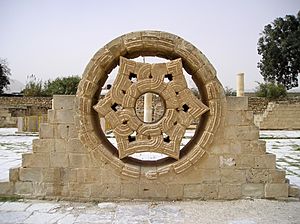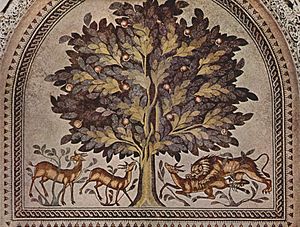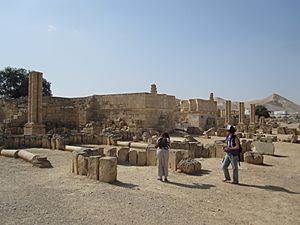Hisham's Palace facts for kids
|
قصر هشام
|
|
 |
|
| Alternative name | Khirbet al-Mafjar |
|---|---|
| Location | Jericho Governorate, West Bank, State of Palestine |
| Coordinates | 31°52′57″N 35°27′35″E / 31.88250°N 35.45972°E |
| Type | Umayyad qasr |
| History | |
| Founded | 724–743 |
| Periods | Early Islamic period |
| Cultures | Umayyad |
| Site notes | |
| Public access | Yes |
Hisham's Palace (which in Arabic is Qaṣr Hishām) is also known as Khirbat al-Mafjar. It is a very old and important archaeological site in the city of Jericho, in Palestine. This amazing palace was built by the Umayyad family in the early 700s. It is one of the famous Umayyad desert castles. You can find it about 3 kilometers north of Jericho's city center.
The site is huge, covering about 60 hectares (which is like 150 football fields!). It has three main parts: a palace, a fancy bath complex, and a farm area. There was also a large park or farming area (called a ḥayr) connected to the palace. All these parts – the palace, baths, and farm – got their water from nearby springs through a clever water system.
Contents
Discovering Hisham's Palace
The ruins of Hisham's Palace were first found in 1873. Later, in 1894, F. J. Bliss looked at the northern part of the site but did not dig there. Most of what we know about the palace comes from the work of a Palestinian archaeologist named Dimitri Baramki. He led big digs between 1934 and 1948.
In 1959, Robert Hamilton, who worked with Baramki, wrote an important book about the palace. Many of the items found during these digs, like pottery and decorations, are now kept in the Rockefeller Museum in Jerusalem.
More recently, new digs started in 2006. These are led by Dr. Hamdan Taha from the Palestinian Ministry of Tourism and Antiquities. Today, archaeologists from the University of Chicago are also working with the ministry to learn even more about the site.
In 2015, a special agreement was made with a Japanese agency. This agreement helped to uncover and prepare a huge mosaic floor in the palace for visitors. It is one of the biggest mosaics in the world!
Who Built Hisham's Palace?
It's a bit tricky to know the exact history of Hisham's Palace. We don't have old writings that talk about it. So, archaeologists have to learn everything from the ruins they dig up.
During Baramki's excavations, they found a piece of pottery with the name "Hisham" on it. This made people think the palace was built when Caliph Hisham ibn Abd al-Malik was in charge. Later, Robert Hamilton suggested that the palace was a home for al-Walid ibn Yazid. He was Hisham's nephew and known for living a very fancy life.
What we know for sure is that the Umayyad family built this site in the early 700s. But exactly who ordered it and how it was used is still a bit of a mystery!
What are Desert Castles?
Hisham's Palace is part of a group called "desert castles." These are buildings from the Umayyad time found across places like Syria, Jordan, Israel, and the West Bank. They are all different in size and what they were used for. But they were all built by members of the Umayyad ruling family.
Some desert castles, like Qasr Hallabat, were built on top of older Roman buildings. Others, like Qasr Azraq, were near trade routes or important water sources. Most desert castles have a square palace, a bathhouse, and a way to store water. They often also have a farming area.
Scientists have many ideas about why these desert castles were built. It's likely that they had different purposes, not just one single reason.
When Was the Palace Destroyed?
Many people used to think that Hisham's Palace was destroyed by a big earthquake in 749. Then, they thought it was left empty. However, new studies of the pottery found there show that people continued to live at the site for a long time after that. They lived there through the Abbasid and Fatimid periods, especially between 900 and 1000 AD.
More recent studies in 2013 suggest that a later, even stronger earthquake in 1033 might have been the one that truly destroyed the palace. This earthquake caused more severe damage to the buildings.
Exploring the Palace Buildings
The palace, the bath complex, and an outside mosque are all surrounded by a strong wall. Archaeologists found a southern gate a long time ago. More recently, they found a northern gate. This shows that Hisham's Palace was planned and built as one complete project.
The Palace Building
The biggest building at the site is the palace itself. It's a roughly square building with round towers at each corner. It used to have two floors. You would enter through a gate on the east side. Inside, the rooms were built around a central paved area called a riwaq. This area had an underground cellar (or sirdab) where people could escape the heat. A room to the south of this area was a mosque with a special prayer niche (a mihrab) in its outer wall.
The Bath Complex
The bath complex is just north of the palace. It's a large, square building, about 30 meters (almost 100 feet) on each side. It has round sections called exedrae sticking out from three of its sides. The east side of the bathhouse had a very fancy entrance.
The floor inside the main bath complex was covered with amazing mosaic art. There was also a special reception room, or diwan, in the northwest corner. The floor of this room has the famous "tree of life" mosaic. This mosaic shows a tree with a lion attacking a gazelle on one side and two peaceful gazelles on the other.
The actual bathing rooms were connected to the north wall. They were heated from underneath the floor using a system called hypocausts.
The Farm Area
North of the bath complex are the remains of a large square building. This area was once thought to be a khan (a guesthouse for travelers). However, recent digs show that this northern area was used for farming. It was connected to the hayr, or agricultural enclosure, during the Umayyad and Abbasid periods.
Beautiful Art and Decorations
The decorations at Hisham's Palace are some of the best examples of Umayyad art. They are very well-known and studied.
Amazing Mosaics
The floor of the main bathing hall is covered with colorful geometric mosaics. In the center, there's a huge design that looks like a kaleidoscope. This enormous mosaic is divided into 25 square sections, each with different geometric patterns. The colors used are mostly blue, red, green, yellow, and orange.
After many years of careful work, funded by Japan, this huge mosaic was fully uncovered in October 2021. It covers about 836 square meters (about 9,000 square feet) and has more than five million tiny pieces of stone from Palestine. It is one of the largest floor mosaics from the ancient world that we still have today!
The most famous mosaic is the "Tree of Life" in the diwan, or private reception room. This mosaic shows a tree with fruit. On one side, two gazelles are peacefully eating. On the other side, a lion is attacking another gazelle. People have many ideas about what this mosaic means. One idea is that it shows the peace the caliph brought with his strength.
Carved Stucco Decorations
The carved stucco (a type of plaster decoration) found at the palace is also incredibly detailed. One special piece is a statue of a man with a sword. Many people think this statue shows the caliph himself. It stood in a special spot above the entrance to the bath hall.
You can also find other carved figures of men and women, some partly nude, decorating the bath complex. Geometric shapes and plant patterns are also very common.
Some art historians have noticed that the art at Hisham's Palace looks similar to Iranian designs. This suggests that the art here was part of a larger Islamic art style that spread from influences in Iraq.
Protecting This Ancient Site
The area around Jericho is growing quickly with new buildings and farms. This makes it harder for archaeologists to explore parts of Hisham's Palace that are still hidden. Also, efforts to protect the important structures have been difficult because of a lack of money.
In 2010, a group called Global Heritage Fund said that Hisham's Palace was one of 12 world heritage sites most in danger of being lost forever.
However, in 2021, a big project finished restoring the bath complex's huge mosaic floor. This project cost 12 million US dollars and was funded by Japan. A special dome-shaped roof was built to protect the mosaics. Now, visitors can walk on pathways above the floor and admire the beautiful art safely.
Visiting Hisham's Palace
Hisham's Palace is one of the most important Islamic historical places in Palestine. It attracts many visitors, both locals and tourists. In 2010, over 43,000 people visited the site. It's a popular place for Palestinian schoolchildren to go on field trips. Many foreign visitors coming into Palestine make Hisham's Palace their first stop. The site has also hosted important guests and was even used as a setting for a play once!
Since 2021, the amazing mosaic floor of the bath complex is fully open to the public. Thanks to the restoration work and the new protective roof, everyone can now enjoy this incredible piece of history.
See also
 In Spanish: Palacio de Hisham para niños
In Spanish: Palacio de Hisham para niños
- Desert castles
- History of medieval Arabic and Western European domes




